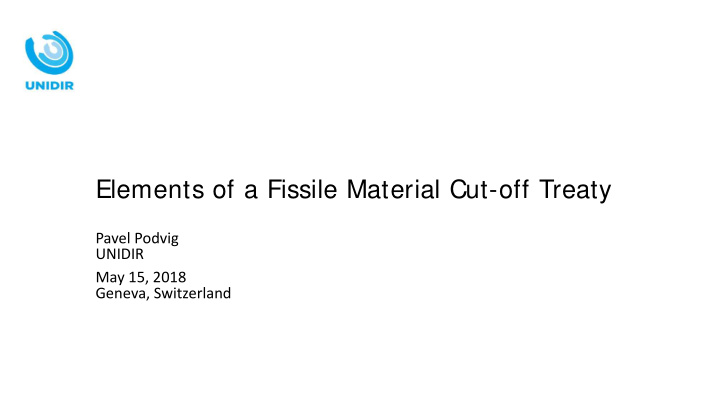



Elements of a Fissile Material Cut-off Treaty Pavel Podvig UNIDIR May 15, 2018 Geneva, Switzerland
Recent developments • 2017-2018: High Level Expert Preparatory Group • 2015: Draft treaty submitted by France • 2014-2015: Work of the Group of Governmental Experts • Views submitted by States • GGE deliberations and final report • Earlier drafts (International Panel on Fissile Materials and others), expert discussions
Dynamic inter-relationship • Definitions • Verification • Scope
Definitions of fissile material All enriched uranium (including LEU) Article XX of the IAEA Statute All plutonium (separated or in spent fuel) Highly enriched uranium (>20% U-235 or U-233) Unirradiated direct use material All separated plutonium Weapon-grade HEU (>90% U-235) Fissile material Weapon-grade material Separated weapon-grade plutonium Excludes naval HEU (up to ~60% U-235) Intermediate-grade material Excludes reactor-grade plutonium Other definitions May include Np, Am
Ban on production of fissile material for weapons • Fissile material that is produced (or acquired from any source) should be declared and submitted to verification • Verification system is designed to ensure that • Submitted material is not used for nuclear weapons • Once submitted, material cannot be withdrawn • No material is produced that is not submitted to verification
Components of the verification system • Verification at production facilities • All produced material is declared and submitted to verification • Downstream verification • Fissile material is not withdrawn or diverted • Fissile material is not used for weapon purposes • Detection of undeclared production • No covert production facilities
Production and production facilities • Production is any activity or process that produces fissile materials • Specific definition depends on the definition of fissile material • Production facility is any facility that is capable of producing fissile materials • “Capable of producing” vs. “configured to produce” or “licensed to produce”
Verification at production facilities • Procedures would have to be facility-specific • Initial declaration should include all “capable” facilities • Should the declaration include former production facilities? • Implementing organization decides on specific verification measures • Some facilities may be exempt (laboratory-scale, converted, shut down, dismantled etc.)
Downstream verification • Irreversibility • Once submitted, material cannot be withdrawn • Material cannot be used for weapon purposes • Non-proscribed military uses may require a special arrangement • Military naval reactors, military research reactors • Article 14 of the INFCIRC/153 may or may not be a good model • Transfers to other states
Detection of undeclared production • Undeclared production at declared production facilities • Should be prevented by facility-specific verification measures • May require “upstream” verification arrangements (similar to additional protocol) • Production at undeclared facilities • May require non-routine inspections and other measures
Existing stocks • FMCT would create a system for handling existing materials • Any existing material can be submitted to verification • Material voluntarily declared excess • ”Disarmament material”
Conclusions • There is a broad agreement on the key elements of the FCMT, even though differences remain • FMCT can be an essential element of nuclear disarmament whether or not it mandates elimination of fissile materials
Recommend
More recommend